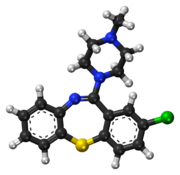Clotiapine (original) (raw)
From Wikipedia, the free encyclopedia
Antipsychotic medication
Pharmaceutical compound
Clotiapine
 |
|
|---|---|
 |
|
| Clinical data | |
| Trade names | Etumina, Etumine, Entumin, Etomine, Entumine |
| AHFS/Drugs.com | International Drug Names |
| Routes of administration | Oral, Intravenous and Intramuscular |
| ATC code | N05AH06 (WHO) |
| Legal status | |
| Legal status | BR: Class C1 (Other controlled substances)[1] In general: ℞ (Prescription only) |
| Identifiers | |
| IUPAC name 8-chloro-6-(4-methylpiperazin-1-yl)benzo[b][1,4]benzothiazepine | |
| CAS Number | 2058-52-8  N N |
| PubChem CID | 16351 |
| ChemSpider | 15510  Y Y |
| UNII | Z05HCY0X1T |
| KEGG | D01597  Y Y |
| ChEBI | CHEBI:108591 |
| ChEMBL | ChEMBL304902  Y Y |
| CompTox Dashboard (EPA) | DTXSID5022851 |
| ECHA InfoCard | 100.016.512 |
| Chemical and physical data | |
| Formula | C18H18ClN3S |
| Molar mass | 343.87 g·mol−1 |
| 3D model (JSmol) | Interactive image |
| SMILES Clc2ccc1Sc4c(/N=C(\c1c2)N3CCN(C)CC3)cccc4 | |
InChI InChI=1S/C18H18ClN3S/c1-21-8-10-22(11-9-21)18-14-12-13(19)6-7-16(14)23-17-5-3-2-4-15(17)20-18/h2-7,12H,8-11H2,1H3  YKey:KAAZGXDPUNNEFN-UHFFFAOYSA-N YKey:KAAZGXDPUNNEFN-UHFFFAOYSA-N  Y Y |
|
 N N Y (what is this?) (verify) Y (what is this?) (verify) |
Clotiapine (Entumine) is an atypical antipsychotic[2] of the dibenzothiazepine chemical class.[3] It was first introduced in a few European countries (namely, Belgium, Italy, Spain and Switzerland), Argentina, Taiwan and Israel in 1970.[4]
Some sources regard clotiapine as a typical antipsychotic rather than atypical due to its high incidence of extrapyramidal side effects compared to the atypicals like clozapine and quetiapine, to which it is structurally related.[5] Despite the relativity high rate of undesired effects it has demonstrated efficacy in treatment-resistant individuals with schizophrenia according to a number of psychiatrists with clinical experience with it, some weak clinical evidence supports this view too.[4][5][6] A systematic review performed by Cochrane compared clotiapine with other antipsychotic drugs:
Clotiapine compared to other antipsychotic drugs for acute psychotic illnesses[7]
| Summary |
|---|
| There was no evidence to support or refute the use of clotiapine in preference to other antipsychotic drug treatments for management of people with acute psychotic illness.[7] |
| Outcome Findings in words Findings in numbers Quality of evidence General clinical impression No significant improvement There is no clear difference between people given clotiapine and those receiving other antipsychotic drugs for acute psychotic illnesses. These findings are based on data of low quality. RR 0.88 (0.39 to 1.98) Low Not well enough to be discharged Clotiapine is not clearly different to other antipsychotic drugs for this outcome - for people who are acutely unwell. These findings are based on data of low quality. RR 1.04 (0.93 to 1.16) Low Adverse effects Movement disorders - use of antiparkinsonian medication Clotiapine may reduce the use of antiparkinsonian drugs - implying that clotiapine causes less of this effect, but, at present it is not possible to be confident about the difference between the two treatments and data supporting this finding are very limited. RR 0.43 (0.05 to 3.53) Very low Seizure Clotiapine may increase the risk of fits, but, the difference between the two treatments is not clear. This finding is based on data of low quality. RR 3.67 (0.16 to 84.66) Low Satisfaction with care Leaving the study early - any reason There is no clear difference between people given clotiapine and those receiving other antipsychotics for acute psychotic illnesses. These findings are based on data of low quality. RR 2.09 (0.81 to 5.42) Low No study reported any data on outcomes as sedation and information relating to behavioral outcomes such as tranquillisation. Clotiapine increases very fast weight, like approximately in 6 or 7 days of the start, so it is convenient to speak with your doctor it this happens. |
A fatal case of urinary retention associated with this drug has been reported in literature.[8]
- ^ Anvisa (2023-03-31). "RDC Nº 784 - Listas de Substâncias Entorpecentes, Psicotrópicas, Precursoras e Outras sob Controle Especial" [Collegiate Board Resolution No. 784 - Lists of Narcotic, Psychotropic, Precursor, and Other Substances under Special Control] (in Brazilian Portuguese). Diário Oficial da União (published 2023-04-04). Archived from the original on 2023-08-03. Retrieved 2023-08-16.
- ^ Seminara G, Trassari V, Prestifilippo N, Chiavetta R, Calandra C (June 1993). "[Atypical tricyclic neuroleptics for treatment of schizophrenia. Clothiapine and clozapine]". Minerva Psichiatrica. 34 (2): 95–99. PMID 8105359.
- ^ Schmutz J, Künzle F, Hunziker F, Gauch R (1967). "Über in 11-Stellung amino-substituierte Dibenzo[b,f]-1, 4-thiazepine und -oxazepine. 9. Mitteilung über siebengliedrige Heterocyclen". Helvetica Chimica Acta. 50: 245–254. doi:10.1002/hlca.19670500131.
- ^ a b Lokshin P, Kotler M, Belmaker RH (September 1997). "Clotiapine: Another forgotten treasure in psychiatry?". European Neuropsychopharmacology. 7 (Suppl 2): S217. doi:10.1016/S0924-977X(97)88712-3. S2CID 54246576.
- ^ a b Geller V, Gorzaltsan I, Shleifer T, Belmaker RH, Bersudsky Y (December 2005). "Clotiapine compared with chlorpromazine in chronic schizophrenia". Schizophrenia Research. 80 (2–3): 343–347. doi:10.1016/j.schres.2005.07.007. PMID 16126373. S2CID 22340010.
- ^ Van Wyk AJ, Marais GF (August 1971). "Chlorpromazine, clotiapine and thioridazine--a comparative clinical trial on Bantu psychotic patients" (PDF). South African Medical Journal = Suid-Afrikaanse Tydskrif vir Geneeskunde. 45 (34): 945–947. PMID 4939661.
- ^ a b Carpenter S, Berk M, Rathbone J (October 2004). "Clotiapine for acute psychotic illnesses". The Cochrane Database of Systematic Reviews. 2004 (4): CD002304. doi:10.1002/14651858.CD002304.pub2. PMC 8985500. PMID 15495032.
- ^ Mannocchi G, Pantano F, Tittarelli R, Catanese M, Umani Ronchi F, Busardò FP (2015) Development and Validation of a GC-MS Method for the Detection and Quantification of Clotiapine in Blood and Urine Specimens and Application to a Postmortem Case. Int J Anal Chem 2015 ():972480. DOI:10.1155/2015/972480 PMID: 26236337